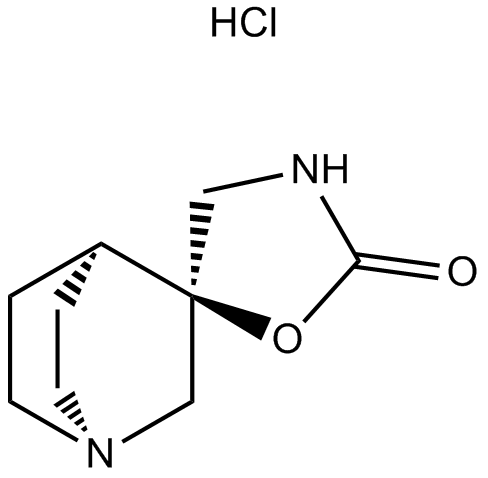AR-R 17779 hydrochloride |
| Catalog No.GC11060 |
El clorhidrato de AR-R 17779 es un agonista completo potente y selectivo de nAChR, con Kis de 92 y 16000 nM para el subtipo α7 y α4β2, respectivamente.
Products are for research use only. Not for human use. We do not sell to patients.

Cas No.: 178419-42-6
Sample solution is provided at 25 µL, 10mM.
AR-R 17779 is a selective agonist of α7 nicotinic acetylcholine receptor (α7-nAChR) [1] with an EC50 of 21 μM to rat α7-nAChRs expressed in Xenopus oocytes [2].
Nicotine enhances cognitive functions, e.g. learning, attention, retention and memory in both humans and animals, via activation of brain nicotinic acetylcholine receptors (nAChRs). These receptors are homo- or heteropentameric ligand-gated ion channels. The most common nicotinic receptors found in the brain are the α4β2-nAChR and the α7-nAChR [3].
The expression of CD38, CD138, and Bcl-6, was sensitive to regulation via nAChRs. Daudi cells exposed to AR-R 17779 ± methyllycaconitine (MLA) resulted in only moderate changes in the gene expression of CD38, CD138 and Bcl-6, but AR-R 17779 alone significantly (P< 0.05) increased protein levels of CD38 and CD138. That means the effect of AR-R 17779 was abolished by MLA [4].
Cholesterol is necessary for the homeostasis of acetylcholine receptor (AChR) levels for ion translocation and at the plasmalemma [5]. In ApoE-deficient mice, AR-R 17779 significantly reduced atherosclerotic plaque area in the thoracic aorta, and lowered heart rate, blood pressure, serum triglyceride level and serum total cholesterol level compared with which in Ang II + HFD mice. Treatment with AR-R 17779 in mice did not result in any sickness behavior or apparent abnormalities. At the end of the experiment, the serum concentration of AR-R 17779 was 1.18 ± 0.17 μM. In ApoE-deficient mice, treatment with AR-R 17779 resulted in significantly reduced aortic diameter comparable to control mice (0.81 ± 0.11 mm, p< 0.0001 vs. Ang II + HFD) [1].
References:
[1]. Toru Hashimoto, Toshihiro Ichiki, AyaWatanabe, et al. Stimulation of α7 nicotinic acetylcholine receptor by AR-R17779 suppresses atherosclerosis and aortic aneurysm formation in apolipoprotein E-deficient mice. Vascular Pharmacology, 2014, 61:49-55.
[2]. Rudy Schreiber, Marion Dalmus and Jean De Vry. Effects of α4/β2- and α7-nicotine acetylcholine receptor agonists on prepulse inhibition of the acoustic startle response in rats and mice. Psychopharmacology, 2002, 159:248-257.
[3]. Marja van Kampen, Karin Selbach, Renate Schneider, et al. AR-R 17779 improves social recognition in rats by activation of nicotinic α7 receptors. Psychopharmacology, 2004, 172:375-383.
[4]. Juan Arredondo, Denys Omelchenko, Alexander I Chernyavsky, et al. Functional role of the nicotinic arm of the acetylcholine regulatory axis in human B-cell lines. Journal of Experimental Pharmacology, 2009, 1:1-7.
[5]. Virginia Borroni and Francisco J. Barrantes. Cholesterol Modulates the Rate and Mechanism of Acetylcholine Receptor Internalization. J. Biol. Chem., 2011, 286(19):17122-32.
Average Rating: 5 (Based on Reviews and 28 reference(s) in Google Scholar.)
GLPBIO products are for RESEARCH USE ONLY. Please make sure your review or question is research based.
Required fields are marked with *




















